“From the Prophet’s Life: A Photo Essay,” Ensign, Jan. 1984, 32
From the Prophet’s Life:
A Photo Essay
“Before I saw Joseph I did not care how old he was, or how young he was,” wrote Wilford Woodruff. “I did not care how he looked—whether his hair was long or short; the man that advanced that revelation was a prophet of God. I knew it for myself. I first met Joseph Smith in the streets of Kirtland. He had on an old hat, and a pistol in his hand. Said he, ‘Brother Woodruff, I’ve been out shooting at a mark, and I wanted to see if I could hit anything.’ And, said he, ‘Have you any objection to it?’
“‘Not at all,’ said I. ‘There is no law against a man shooting at a mark, that I know of.’
“He invited me to his house. He had a wolf skin, which he wanted me to help him to tan; he wanted it to sit on while driving his wagon team. Now, many might have said, ‘You are a pretty prophet; shooting a pistol and tanning a wolf skin.’ Well, he tanned it, and used it while making a journey of a thousand miles. This was my first acquaintance with the Prophet Joseph. And from that day until the present, with all the apostasies we have had, and with all the difficulties and afflictions we have been called to pass through, I never saw a moment when I had any doubt with regard to this work. I have had no trial about this. While the people were apostatizing on the right hand and on the left, … it was no temptation to me to doubt this work or to doubt that Joseph Smith was a prophet of God.” (Discourses of Wilford Woodruff, ed. G. Homer Durham, Salt Lake City: Bookcraft, 1946, pp. 29–30.)
The hat and the wolf skin Brother Woodruff mentions may have disappeared over the years, but many items the Prophet used are still in existence. In the following pages, we present some of these, as well as a few items owned by Emma Hale Smith, the Prophet’s wife, and Lucy Mack Smith, his mother. Included in the photographs are such things as the Prophet’s family Bible, his hymnbook, and his eyeglasses. We even see a pistol he owned—perhaps the very one he was holding when Wilford Woodruff first met him.
Latter-day Saints do not revere these objects, of course. They are not icons or religious relics. They are historical artifacts, items from another time and place that tell us something about the persons they were associated with.
At this point in this dispensation, we cannot personally meet Joseph Smith. But we have a link with him, through the physical memorabilia we have of him, and through his work as the great prophet of the restoration of the gospel of Jesus Christ in these latter days.
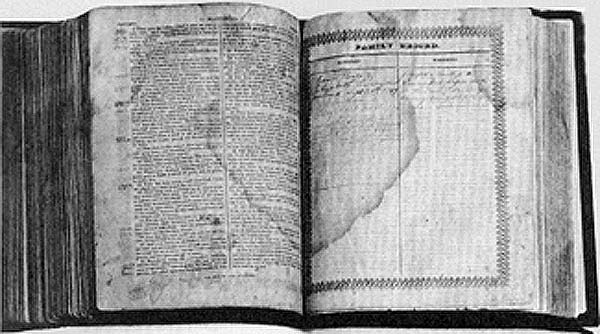
Joseph Smith, Jr., family Bible. The Prophet’s marriage entry contains the handwriting of both Joseph and Emma Smith. (Photography by M. House. Joseph Smith Bible shown courtesy of Buddy Youngreen.)

Hyrum Smith family Bible. Hyrum Smith’s marriage entries are reportedly in the handwriting of Hyrum Smith; of his first wife, Jerusha Barden; and of his second wife, Mary Fielding. Both Bibles were published in Boston in the 1830s and were purchased during the Church’s Kirtland period. (Photography by M. House. Hyrum Smith Bible shown courtesy of Elder Eldred G. Smith, Patriarch Emeritus of the Church and a great-great-grandson of Hyrum and Jerusha Barden Smith.)

A page from the family Bible of Joseph Smith, Jr. The handwriting records the marriages of Isaac Hale and Elizabeth Lewis in 1789; Joseph Smith, Sr., and Lucy Mack in 1796; Joseph Smith, Jr., and Emma Hale in 1827, apparently in their own handwriting, according to Dean C. Jessee of the Joseph Fielding Smith Institute; and Joseph Smith III and Emma Griswold in 1856. (Photography by M. House; shown courtesy of Buddy Youngreen.)
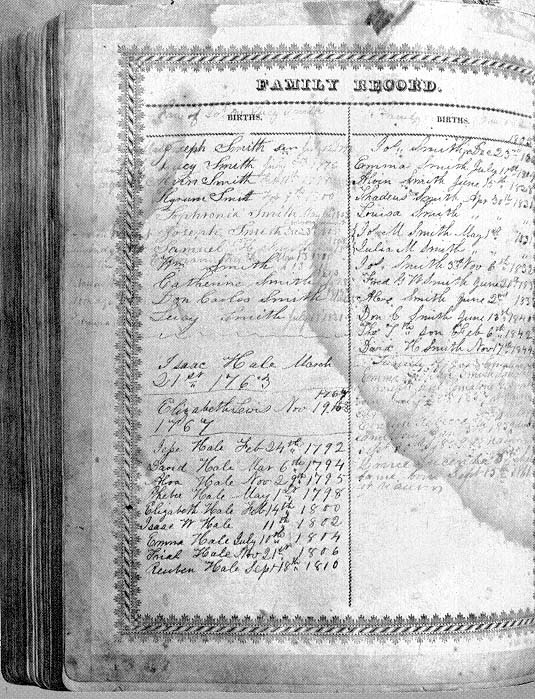
A page from the Joseph Smith, Jr., family Bible. The handwriting records the names of Joseph Smith, Sr., and Lucy Mack Smith and their children, Isaac and Elizabeth Lewis Hale and their children, and Joseph and Emma Smith and their children. (Photography by M. House; shown courtesy of Buddy Youngreen.)

Lucy Mack Smith’s dinner bell. This is quite possibly the bell Joseph Smith, Sr., used to summon the children of his school together when he was teaching during the early part of the nineteenth century. (Photography by Jed A. Clark; shown courtesy of Elder Eldred G. Smith.)

Footstool of the Prophet’s mother, Lucy Mack Smith, with her 1840 edition of the Book of Mormon resting on it. (Photography by Jed A. Clark. Footstool shown courtesy of Elder Eldred G. Smith; Book of Mormon shown courtesy of Buddy Youngreen.)

A promissory note, written and signed by “Joseph Smith.” The note, dated in Palmyra, 24 December 1829 says, “One year after date I promise to pay to the Order of George Booth Two hundred and forty six Dollars value received with Two Percent interest from date.” (Photography by Eldon K. Linschoten; shown courtesy of Brent Ashworth.)

Hyrum Smith’s early Kirtland diary, measuring 3″ x 4″. The cloth cover of the diary was hand-painted and may have been made by Lucy Mack Smith. (On pages 70 and 107 of Lucy Mack Smith’s 1853 edition of Biographical Sketches of Joseph Smith the Prophet and His Progenitors for Many Generations, she mentions painting oil-cloth to bring in money for the family. Photography by Jed A. Clark; shown courtesy of Elder Eldred G. Smith.)

A collar and vest worn by Joseph Smith, Jr. (Photography by Jed A. Clark; shown courtesy of Pioneer Memorial Museum, Salt Lake City.)

Detail from a vest that belonged to Joseph Smith, Jr. (Photography by Jed A. Clark; shown courtesy of Pioneer Memorial Museum, Salt Lake City.)

The Prophet Joseph Smith’s dressing case. The case, made in England, contains a razor strop, brushes, jars for salves, and a pair of “pulls” for boots. Designed as part of the handles of the pulls are a button-hook and a screwdriver. (Photography by Gary Plowman; shown courtesy of Lynn E. Smith.)


The Prophet’s spectacles and hymnbook. These dress glasses were evidently not for practical use, as the frames contain plain glass. The hymnbook, which has the words “Joseph Smith, Jun.” inscribed in gold print on the cover, was printed in Liverpool, England, in 1840. In October 1840 the Prophet wrote a letter to the Council of the Twelve, who were then on a mission in Great Britain, saying, “I have been favored by receiving a hymnbook from you, and as far as I have examined it, I highly approve of it, and think it to be a very valuable collection.” (History of the Church, 4:228. Photography by Dale P. White; shown courtesy of Ruth Derk, a great-great-granddaughter of Joseph and Emma Smith.)

A nightstand from the Nauvoo Mansion House. (Photography by Jed A. Clark; shown courtesy of the Church Historical Department.)

The Prophet Joseph’s gold ring. This ring probably dates from the Nauvoo period and may have been the ring he used in the April 1844 King Follett sermon to illustrate the eternal nature of man. (See Teachings of the Prophet Joseph Smith, p. 354.) Sometime after the Prophet’s martyrdom in 1844, Emma Smith gave the ring to Alexander Hale Smith, one of their sons. (Photography by Gary Plowman; shown courtesy of Glaud Leslie Smith, a great-grandson of Joseph and Emma Smith.)

Vases from the Prophet’s Nauvoo Mansion House. Joseph and Emma Smith lived in the Mansion House in 1843 and 1844. (Photography by Gary Plowman; shown courtesy of Lynn E. Smith.)

The Prophet Joseph Smith’s red stone watch fob. The fob, possibly agate, measures 2″ x 1 1/2″ and is framed with beaded gold trim. (Photography by Michael M. McConkie; shown courtesy of Buddy Youngreen.)

The Prophet Joseph’s spectacle case, which he used in the 1840s. (Photography by Jed A. Clark; shown courtesy of Pioneer Memorial Museum, Salt Lake City.)

Joseph and Emma Smith’s bureau and mirror. This rosewood veneer bureau, or highboy, was kept in Joseph and Emma Smith’s bedroom. The detachable mirror above the dresser is framed in plain mahogany to match the dresser. (Photography by Gary Plowman; shown courtesy of Lynn E. Smith, a great-grandson of Joseph and Emma Smith.)

Riding crop of Joseph Smith, Jr. The entire crop measures 18″, but appears to have been longer originally. The ivory handle has a carved head of a bulldog at the top. (Photography by Monte Borders; shown courtesy of Edward A. Luce.)

Ladles from the Nauvoo Mansion House. (Photography by Jed A. Clark; shown courtesy of the Church Historical Department.)

Two candlesticks from the Nauvoo Mansion House. (Photography by Jed A. Clark; shown courtesy of the Church Historical Department.)

Emma Smith’s spinning wheel. (Photography by Jed A. Clark; shown courtesy of Pioneer Memorial Museum, Salt Lake City.)
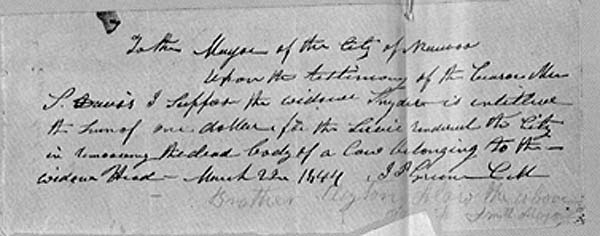
A note to “the Mayor of the City of Nauvoo,” Joseph Smith, on March 22, 1844. The note states that “the widow Snyder” should be reimbursed one dollar for the costs she incurred in “removing the dead body of a Cow belonging to the widow Head.” (Photography by Eldon K. Linschoten; shown courtesy of Brent Ashworth.)
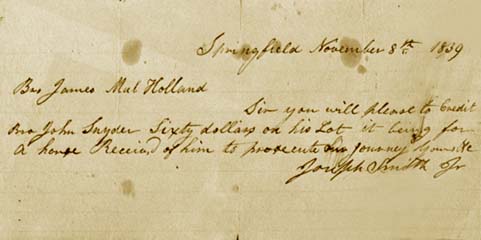
A letter from Joseph Smith to James Mulholland, dated November 8, 1839, about a horse the Prophet received from a Brother John Snyder. (Photography by Eldon K. Linschoten; shown courtesy of Brent Ashworth.)
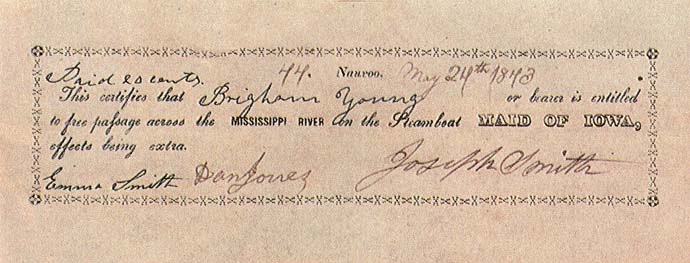
A steamboat ticket, issued to Brigham Young and signed by Joseph Smith, Emma Smith, and Dan Jones. The ticket, dated May 24, 1843, gave Brigham Young passage across the Mississippi River on the Maid of Iowa. (Photography by Eldon K. Linschoten; shown courtesy of Brent Ashworth.)

A receipt for the purchase of “pine lumber” for Joseph Smith’s coffin, dated June 28, 1844. The Prophet was martyred on June 27. (Photography by Eldon K. Linschoten; shown courtesy of Brent Ashworth.)

A letter from Joseph Smith to Emma Smith, March 6, 1833. The letter says:
A lock of the Prophet Joseph Smith’s hair. (Photography by Jed A. Clark; shown courtesy of Pioneer Memorial Museum, Salt Lake City.)
A braided lock of Emma Smith’s hair, which she gave to Jesse N. Smith, first cousin of the Prophet Joseph. (Photography by Ray Miller; shown courtesy of Gracia N. Jones, great-great-granddaughter of Joseph and Emma Smith.)
Handle from a riding crop owned by Emma Smith, and brass buttons believed to be from the Prophet Joseph’s Nauvoo Legion uniform. The ivory handle of the riding crop measures approximately six inches in length, while the entire riding crop is about twenty-two inches long. The box holding the buttons was made by Alexander Hale Smith, one of Joseph’s and Emma’s sons. (Photography by Ray Miller; shown courtesy of James R. Horner, great-great-grandson of Joseph and Emma Smith.)
Joseph Smith’s pistol. (Photography by Jed A. Clark; shown courtesy of the Church Historical Department.)
Doll cape made by Emma Hale Smith for her granddaughter, Vida Elizabeth Smith, who was born in 1865. (Photography by Dale P. White; shown courtesy of Ruth Derk.)
“Dear Wife
“Brother Williams has this day received word from Brother Morely that we should commit the cross plow unto the hands of the poor you will therefor please to trust it to Brother Williams by his hand I send this I subscribe myself your Husband.” (Photography by Eldon K. Linschoten; shown courtesy of Brent Ashworth.)